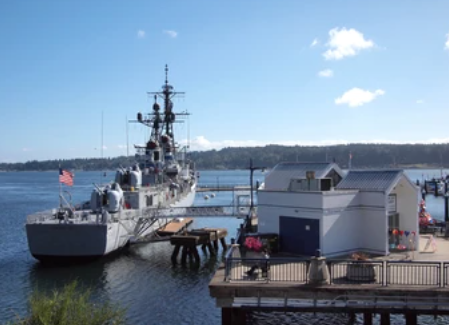Introduction: The Gulf of Tonkin Incident
The Gulf of Tonkin Incident, occurring in August 1964, was a pivotal moment in American history that escalated U.S. involvement in the Vietnam War. This incident involved two separate confrontations between the United States and North Vietnamese naval forces. Understanding the background, events, and implications of the Gulf of Tonkin Incident is crucial for comprehending the complexities of the Vietnam War.
The Background: Preceding Tensions
To fully grasp the significance of the Gulf of Tonkin Incident, it’s essential to explore the geopolitical and regional context that led up to it. The Cold War era was marked by a fierce rivalry between the United States and the Soviet Union, with each superpower striving to expand its influence globally. Vietnam, divided between the communist North and the anti-communist South, became a crucial battleground in this ideological struggle.
The Cold War Context
The Gulf of Tonkin Incident took place during the Cold War, a period characterized by intense geopolitical tension between the United States and the Soviet Union. The U.S. was committed to containing the spread of communism, and Vietnam became a critical battleground in this global struggle. The ideological conflict between communism and capitalism meant that any perceived threat or expansion of communist influence was met with strong resistance by the United States.
The Cold War’s influence on U.S. foreign policy was evident in the Truman Doctrine and the policy of containment, which sought to prevent the spread of communism worldwide. This ideological battle was not just about military might but also about winning hearts and minds through economic and political influence.
Read Also : The Landmark Supreme Court Case of Citizens United v. FEC (2010): Redefining Campaign Finance
North and South Vietnam
Vietnam was divided into two distinct political entities: the communist North, led by Ho Chi Minh, and the anti-communist South, supported by the United States. The division stemmed from the Geneva Accords of 1954, which temporarily split Vietnam at the 17th parallel, intending to reunite the country through national elections. However, these elections never took place, leading to a prolonged and violent conflict.
The United States provided military and economic assistance to South Vietnam in an effort to bolster its government and prevent the spread of communism. This support included advisors, military equipment, and financial aid aimed at strengthening South Vietnam’s capacity to resist North Vietnamese and Viet Cong forces. This division and the ongoing conflict between the North and South set the stage for the Gulf of Tonkin Incident.
The Incident: What Happened in the Gulf of Tonkin?
With the background set, it’s time to delve into the specifics of the Gulf of Tonkin Incident. This incident comprises two separate encounters between U.S. naval forces and North Vietnamese torpedo boats in the waters of the Gulf of Tonkin.
The First Encounter: August 2, 1964
On August 2, 1964, the USS Maddox, a U.S. Navy destroyer, was conducting a patrol in the Gulf of Tonkin as part of a mission called DESOTO Patrols. These patrols were intelligence-gathering operations aimed at monitoring North Vietnamese coastal defenses. The Maddox reported being approached and attacked by three North Vietnamese torpedo boats.
The confrontation began when the Maddox detected the torpedo boats on radar and prepared for a potential attack. The North Vietnamese boats fired torpedoes and machine guns at the Maddox, which responded with 5-inch gunfire and called in air support from the nearby aircraft carrier, USS Ticonderoga. The engagement resulted in damage to the North Vietnamese boats, with one sinking, and minor damage to the Maddox. No American casualties were reported.
The Second Encounter: August 4, 1964
Two days later, on the night of August 4, the USS Maddox and the USS Turner Joy, another destroyer, reported a second attack by North Vietnamese forces. In heavy weather and darkness, the crews believed they were under fire and engaged in a defensive response, firing their weapons and maneuvering aggressively. However, subsequent investigations cast doubt on whether this second attack actually occurred.
The radar and sonar signals that indicated the presence of enemy vessels were later attributed to weather effects and over-eager sonar operators. No physical evidence of torpedo attacks, such as recovered fragments, was found. This uncertainty raised significant questions about the legitimacy of the reports used to justify military action.
The U.S. Response: Escalation of Military Involvement
Understanding the immediate aftermath of the Gulf of Tonkin Incident is key to recognizing its impact on U.S. military strategy. The perceived attacks prompted a swift and decisive response from the American government, leading to a significant escalation in military involvement in Vietnam.
The Gulf of Tonkin Resolution
In response to the reported attacks, President Lyndon B. Johnson sought and received congressional approval for the Gulf of Tonkin Resolution on August 7, 1964. This resolution granted the President broad authority to use military force in Vietnam without a formal declaration of war. It marked a significant turning point, providing the legal justification for increased U.S. military engagement in the region.
The resolution passed overwhelmingly in both the House and the Senate, reflecting the strong bipartisan support for taking a hard stance against communist aggression. It effectively gave President Johnson a “blank check” to conduct military operations in Southeast Asia, leading to a dramatic escalation of U.S. involvement in the Vietnam War.
Military Escalation
Following the resolution, the United States significantly escalated its military presence in Vietnam. The number of U.S. troops deployed to the region increased dramatically, and American military operations expanded. This escalation marked the beginning of a more intense phase of the Vietnam War, with far-reaching consequences for both the United States and Vietnam.
Operation Rolling Thunder, a sustained bombing campaign against North Vietnam, was initiated in 1965, signaling a significant shift from advisory and support roles to direct combat involvement. The escalation continued with the deployment of ground troops, leading to prolonged and brutal combat that would define the Vietnam War.
The Controversy: Debating the Incident
The Gulf of Tonkin Incident has been the subject of much debate and controversy. Understanding these debates is crucial for a comprehensive view of its historical significance and the differing perspectives on what truly transpired.
Conflicting Accounts
There are conflicting accounts regarding the events of August 4, 1964. While the initial reports suggested a second attack on the USS Maddox and USS Turner Joy, subsequent investigations and declassified documents have raised questions about the accuracy of these reports. Some evidence suggests that the second attack may have been a misinterpretation of radar and sonar signals, possibly caused by weather conditions and equipment malfunctions.
In 2005, a declassified National Security Agency (NSA) report concluded that there was no North Vietnamese naval attack on August 4. The report suggested that the reports of the second attack were due to “errors and confusion” rather than deliberate falsehoods, highlighting the fog of war and the challenges of decision-making under uncertainty.
Political Ramifications
The controversy surrounding the Gulf of Tonkin Incident has significant political ramifications. Critics argue that the Johnson administration may have used the incident to justify a predetermined decision to escalate U.S. involvement in Vietnam. The lack of clear evidence and the subsequent revelation of possible misinterpretations have led to accusations of manipulation and deceit, further fueling debates about the legitimacy of the U.S. actions in Vietnam.
The incident has been compared to other controversial events in U.S. history, such as the lead-up to the Iraq War in 2003, where intelligence and justifications for military action were later questioned. These comparisons underscore the importance of critical scrutiny and transparency in government decision-making.
The Impact on U.S. Foreign Policy
The Gulf of Tonkin Incident not only influenced the course of the Vietnam War but also had a lasting impact on U.S. foreign policy. Examining this impact helps to understand how a single event can shape a nation’s approach to international relations.
Expansion of Presidential Power
The Gulf of Tonkin Resolution significantly expanded presidential power, allowing the President to engage in military actions without explicit congressional approval. This shift in the balance of power has had lasting implications, influencing how future administrations approach foreign policy decisions and military engagements.
The resolution set a precedent for subsequent conflicts, where Presidents have cited similar authorizations to justify military interventions. This expansion of executive power has led to debates about the appropriate role of Congress in authorizing and overseeing the use of military force.
Precedent for Future Conflicts
The precedent set by the Gulf of Tonkin Incident and the subsequent resolution has been cited in future conflicts. Presidents have used similar justifications to engage in military actions without formal declarations of war, shaping the U.S. approach to international conflicts and interventions.
Examples include the use of military force in Iraq and Afghanistan, where authorizations for the use of military force (AUMFs) provided broad powers to the executive branch. These precedents highlight the enduring impact of the Gulf of Tonkin Incident on U.S. foreign policy and the conduct of military operations.
The Vietnam War: Escalation and Consequences
The Gulf of Tonkin Incident was a catalyst for the escalation of the Vietnam War. Understanding this escalation and its consequences is essential for comprehending the broader implications of the incident.
Increased U.S. Involvement
Following the Gulf of Tonkin Resolution, U.S. involvement in Vietnam escalated rapidly. The number of American troops in Vietnam increased significantly, and the scope of military operations expanded. This escalation marked a turning point in the war, leading to increased casualties and a prolonged conflict.
By 1968, over half a million U.S. troops were deployed in Vietnam, and the war had become a central issue in American politics and society. The Tet Offensive in 1968, a coordinated series of attacks by North Vietnamese and Viet Cong forces, further intensified the conflict and underscored the challenges faced by U.S. forces.
Consequences for Vietnam
The escalation of the Vietnam War had devastating consequences for Vietnam and its people. The increased military presence and intensified combat operations resulted in significant loss of life, widespread destruction, and long-term social and economic impacts. The war also deepened the divisions within Vietnamese society, contributing to a complex and enduring legacy.
The use of chemical defoliants like Agent Orange caused lasting environmental damage and health issues for both Vietnamese civilians and U.S. veterans. The war left a legacy of unexploded ordnance and landmines, posing ongoing risks to communities and impeding development efforts.
The Aftermath: Reflecting on the Incident
Reflecting on the Gulf of Tonkin Incident and its aftermath provides valuable insights into the complexities of war, politics, and historical interpretation. Understanding these reflections is essential for a comprehensive view of the incident’s significance.
Historical Reassessment
Over the years, historians and scholars have reassessed the Gulf of Tonkin Incident, examining newly available evidence and reevaluating the events and decisions of 1964. This reassessment has contributed to a more nuanced understanding of the incident and its impact on U.S. policy and the Vietnam War.
The release of declassified documents and the availability of new research have allowed for a more detailed examination of the incident. Historians have explored the motivations and actions of key decision-makers, providing insights into the complexities of the situation and the challenges of interpreting historical events.
Lessons Learned
The Gulf of Tonkin Incident offers important lessons for future generations. It underscores the need for critical scrutiny of government actions and the importance of transparency and accountability in decision-making. The incident also highlights the complexities of international relations and the far-reaching consequences of military engagements.
One key lesson is the importance of accurate and reliable intelligence in shaping policy decisions. The misinterpretations and errors that led to the Gulf of Tonkin Resolution emphasize the need for rigorous analysis and verification of information before making critical decisions that can lead to war.
Conclusion: The Legacy of the Gulf of Tonkin Incident
The Gulf of Tonkin Incident of 1964 remains a pivotal moment in American history. It served as a catalyst for the escalation of the Vietnam War and had profound implications for U.S. foreign policy and military strategy. Reflecting on this incident helps to understand the complexities of war, the importance of accurate information, and the lasting impact of historical events.
FAQ About The Gulf of Tonkin Incident
What was the Gulf of Tonkin Incident?
The Gulf of Tonkin Incident involved two separate confrontations between U.S. naval forces and North Vietnamese torpedo boats in August 1964. It led to the escalation of U.S. involvement in the Vietnam War.
What led to the Gulf of Tonkin Incident?
The incident was precipitated by ongoing tensions between North and South Vietnam, as well as the broader context of the Cold War and the U.S. commitment to containing communism.
What was the Gulf of Tonkin Resolution?
The Gulf of Tonkin Resolution, passed by Congress in response to the incident, granted President Lyndon B. Johnson broad authority to use military force in Vietnam without a formal declaration of war.
Why is the Gulf of Tonkin Incident controversial?
The incident is controversial due to conflicting accounts and evidence suggesting that the second reported attack may not have occurred. Critics argue that the incident was used to justify a predetermined decision to escalate U.S. involvement in Vietnam.
What impact did the Gulf of Tonkin Incident have on U.S. foreign policy?
The incident significantly expanded presidential power, allowing future administrations to engage in military actions without explicit congressional approval. It set a precedent for U.S. involvement in international conflicts.







Hey I am so happy I found your website, I really found you by accident, while I was searching on Askjeeve for something else, Anyhow I am here now and would just like to say kudos for a tremendous post and a all round thrilling blog (I also love the theme/design), I don抰 have time to browse it all at the moment but I have bookmarked it and also added in your RSS feeds, so when I have time I will be back to read a great deal more, Please do keep up the great work.
Thank you for your articles. http://www.ifashionstyles.com They are very helpful to me. Can you help me with something?